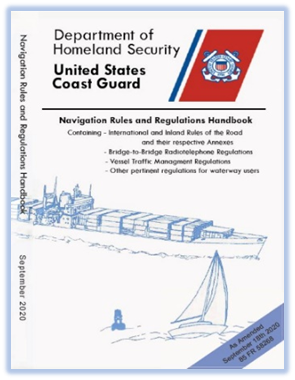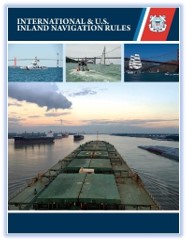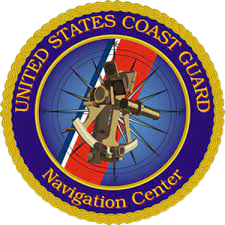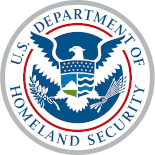- Where can I get a copy of the Navigation Rules?
- Have there been any changes to Navigation Rules?
- What vessels are required to comply with the Navigation Rules?
- Am I required to carry a copy of the Navigation Rules? Are electronic copies of publications acceptable?
- Who has the right of way on the water?
- Rules 24(a-d) -- lights on power-driven vessels --
- What is the safe speed or passing distance for vessels?
- What is a special flashing light?
- What is a narrow channel for the purposes of Rule 9? Are shipping safety fairways defined in 33 CFR 166 also Rule 9 fairways?
- What are the regulations concerning wake effects, wake damage, and responsibility?
- Am I required to have a radar?
- When do I need a look out?
- Where do kayaks and canoes fit into the Navigation Rules?
- Can I use decorative lights strobe or other high-intensity or specialty lights to be more visible at night?
- How do I report a marine accident?
- Who is responsible for damage incurred during a marine accident?
- What does WIG stand for?
- What are demarcation lines and territorial seas?
- What are the Waters specified by the Secretary in Rule 9?
- Are Mobile Offshore Drilling Units (MODU) required to comply with the Navigation Rules?
- Where can I get flash cards or test questions of the Navigation Rules?
- Where can I take a navigation rules course?
- Where can I get a quick guide to the U.S. Aids to Navigation System?
- How does a vessel know another is restricted in their ability to maneuver, not under command, or constrained by a draft?
- Have a navigation question not answered here?
1. Where can I get a copy of the Navigation Rules?
There are a variety of ways to get a copy of the rules of the road. You are welcome to:
- Print our Amalgamated Navigation Rules using the Print button at the top of the webpage (print it to a .pdf).
- Print or download our U.S. Coast Guard Navigation Rules and Regulations Handbook or purchase a hard copy at the U.S. Government Bookstore (GPO Stock Number: 050-012-00520-6). This handbook is a compendium produced by the U.S. Coast Guard Office of Navigation Systems, U.S. Coast Guard Headquarters, Washington, D.C, of the International and Inland Rules of the Road and their respective annexes, the Bridge-to-Bridge Radiotelephone Regulations, and Vessel Traffic Management Regulations.

- Download or print NOAA's Office of Coast Survey illustrated version or use the version contained in each of their United States Coast Pilot®.
- There are also numerous other commercial facsimiles available, however the U.S. Coast Guard does not attest their veracity.


2. Have there been any changes to Navigation Rules? Yes. The changes are available here.
3. What "vessels" are required to comply with the Navigation Rules? In Rule 3 the word vessel includes every description of watercraft, including non-displacement craft, WIG craft, and seaplanes, used or capable of being used as a means of transportation on water.
Courts have interpreted transportation to not just include passengers, but also goods or services.
4. Am I required to carry a copy of the Rules? Per 33 CFR 83.01(g), the operator of each self-propelled vessel 12 meters or more in length shall carry, on board, and maintain for ready reference, a copy of the Inland Rules. A copy of the Amalgamated International & U.S. Inland Rules can be used to meet this requirement. Electronic carriage of the Rules and other required navigation publications (i.e. U.S. Coast Pilot, Sailing Directions, Coast Guard U.S. Light List, List of Lights, Notice to Mariners, Local Notice to Mariners, Notices to Navigation, Vessel Traffic Services User Manual, tide-current and river-current tables) and charts is permissible, but, only as defined in our USCG Navigation and Vessel Inspection Circular 01-16 (CH-2).
5. Who has the "right of way" on the water? The Rules do not grant privileges or rights, they impose responsibilities and require precaution under all conditions and circumstances. Power-driven vessels are to keep out of the way (Rule 18) and either give-way (Rule 16) or stand-on (Rule 17) to vessels not under command or restricted in their ability to maneuver, sailing vessels or vessels engaged in fishing, ascending, or descending a river (Rule 14(d)). Similarly, all vessels should avoid impeding the safe passage of a vessel constrained by her draft (Rule 18), navigating a narrow channel (Rule 9), or traffic separation scheme (Rule 10).
This said, in the United States, the Inland Navigation Rules (Inland Rule 9(a)(ii) do convey a right-of-way in a unique circumstance: to power-driven vessels proceeding downbound with a following current in narrow channels or fairways of the Great Lakes, Western Rivers, or other waters specified by regulation (33 CFR 89.25).
6. Rules 24(a-d) -- lights on power-driven vessels-- The intent of Rule 24 is to state that the towing identification lights on a power driven vessel when towing may be carried in either the location of the forward masthead light or the after masthead light if carried. Rules 24(a) and 24(c) concern the description of the towing identification lights and where they shall be carried. Rule 24 (d) refers to Rule 23(a) which concerns the requirement for the masthead light(s).
7. What is the safe speed or passing distance for vessels?The Navigation Rules do not define a distinct safe speed or passing distance. They do however state, amongst other things, that any alteration of speed or course shall be large enough to be readily apparent and taken early enough to allow sufficient sea room for safe passage or to take proper and effective action to avoid collision or be stopped within a distance appropriate to the prevailing circumstances and conditions.
8. What is a special flashing light? View the Arcs of Visibility page for an explanation of a special flashing light.
9. What is a narrow channel for the purposes of Rule 9? Are shipping safety fairways defined in 33 CFR 166 also Rule 9 fairways? A waterway is deemed a narrow channel or fairway by circumstances and conditions; and, more times than not, by a Court judgment when Rule 9 was not heeded. Narrowness is relative; what is constraining for two container ships would not necessarily be narrow for two canoes. That said, better to error heeding Rule 9 than not.
Note, COLREG and Inland Rule 9 differ. Although both rules require that a vessel overtaking indicate her intentions to do so by sounding the appropriate signal prescribed in Rule 34(c)(i). In the Inland Rule, this only applies to power-driven vessels, and, also requires the power-driven vessel that is to be overtaken to signal as prescribed in Rule 34(c)(i) and (ii) to express agreement or as prescribed in Rule 34(d) to express doubt (as to be overtaken or in a crossing situation). In the COLREG Rule 9, the signal prescribed in Rule 34(d) is optional in an overtaking situation. However, the greatest difference amongst both is that Inland Rule 9(a)(ii) grants a right of way to a power-driven vessel operating in a narrow channel or fairway on the Great Lakes, Western Rivers, or waters that have been specified by the Secretary (which are currently denoted in 33 CFR 89), and proceeding downbound with a following current shall have the right-of-way over an upbound vessel, shall propose the manner and place of passage.
Although a fairway, shipping safety fairways are not necessarily Rule 9 narrow channels or fairways per se. Per 33 CFR 166.100, the purpose of these fairways (and anchorages) are to provide unobstructed approaches for vessels using U.S. ports; 33 CFR 166.105 defines them as a lane or corridor in which no artificial island or fixed structure, whether temporary or permanent, will be permitted; and, temporary underwater obstacles only under certain conditions.
10. What are the regulations concerning wake effects, wake damage, and responsibility? Regarding one's wake, vessels over 1600 Gross Tons (GT) are specifically required by 33 CFR 164.11 to set the vessel's speed with consideration for...the damage that might be caused by the vessel's wake. Further, there may be State or local laws which specifically address "wake" for the waters in question.
While vessels under 1600 GT are not specifically required to manage their speed in regards to wake, they are still required to operate in a prudent matter which does not endanger life, limb, or property (46 USC 2302). Nor do the Navigation Rules exonerate any vessel from the consequences of neglect (Rule 2), which, among other things, could be unsafe speeds (Rule 6), improper lookout (Rule 5), or completely ignoring your responsibilities as prescribed by the Navigation Rules.
As to whether or not a particular vessel is responsible for the damage it creates is a question of law and fact that is best left to the Courts. For more information, contact your local Marine Patrol or State Boating Law Administrator.
11. Am I required to have Radar? Radar is not required on vessels under 1600 GT (33 CFR 164.35), however, Rule 7 states that proper use shall be made of radar equipment if fitted and operational. In other words, whoever has one must use it. The Navigation Rules are not meant to discourage the use of any device, rather they expect prudent mariners to avail themselves of all available means appropriate...as to make full appraisal of the situation (Rule 5), e.g. the use of radar. At issue is whether the use of radar is appropriate in the prevailing circumstances and that is a determination made by the Master; and, ultimately decided by a trier of fact.
Should you be in a collision how would a judge/jury rule on your contention that the use of radar was impracticable (due to electrical drain, crew shortages, etc.)? Also, if a collision does occur, then there was obviously a risk of collision beforehand. Could the determination of that risk have been made sooner with the use of radar? It is difficult to answer such questions because the circumstances of each case are different.
More importantly, remember that Rule 7 specifies that assumptions shall not be made on the basis of scanty information, especially scanty radar information.
12. When do I need a Look-out? According to Rule 5, all vessels are responsible for maintaining a proper look-out at all times - this includes one-man crews, unmanned crafts, and recreational boats.
The term look-out implies watching and listening so that he/she is aware of what is happening around the vessel. The emphasis is on performing the action, not on the person. Still, in all but the smallest vessels, the lookout is expected to be an individual who is not the helmsman and is usually located in the forward part of the boat, away from the distractions and noises of the bridge. While no specific location on a vessel is prescribed for the lookout, good navigation requires placement at the point best suited for the purpose of hearing and observing the approach of objects likely to be brought into collision with the vessel.
The size of the vessel and crew effect this answer, however, the emphasis in every legal decision points to the need for a proper, attentive look-out. While the use of radar to evaluate the situation is implied in the requirement to use all available means, that is still understood to be secondary to maintaining a look-out by sight and hearing.
13. Where do Kayaks and Canoes fit into the Navigation Rules? Kayaks and Canoes are a vessel under oars and are addressed specifically in Rule 25 (lights)
Although a vessel under oars may be lit as a sailing vessel, one should not infer that they are considered to be a sailing vessel for other Rules (i.e. Rule 9, 10, 12, 18 or 35). Ultimately, the issue of whether a vessel under oars is the give way or stand-on vessel would fall to what would be required by the ordinary practice of seamen, or by the special circumstances of the case Rule 2, and, the notion that they are less able than most other vessels.
Per Rule 25(d) they must be lit with 1 of 3 options between sunset and sunrise:
- display the lights of a sailing vessel per Rule 25 and Annex I; or
- display an all-round white light (visible for at least 2 miles [per Rule 22] and meet the technical characteristics [i.e. color, intensity] per Annex I); or
- have at hand either an electric torch (flashlight) or lighted lantern (oil or gas) which need not comply with Rule 22 or Annex I.
- Preferably, option #3 provides similar lighting, intensity and characteristics of an all-around white light (versus a single beam of light);
- may be mounted, worn, stowed, etc so long as it is ready at hand to warn other mariners; and,
- should be used in ample time so as to warn others of danger and in manner consistent with Rule 36, so that it not embarrass any vessel (i.e. so as not to blind or otherwise negatively impact their navigation). See FAQ#14 (below) for a discussion regarding high intensity and flashing lights.
14. Can I use decorative lights, strobes, or other high intensity or specialty lights to be more visible at night? Standard lights are displayed aboard all vessels to help others to identify them and to better understand their maneuvering characteristics or possibly distress. The use of any lights, other than the lights prescribed by the Rules or its Annexes, is discouraged because the use of decorative lights, strobes, or other high intensity or specialty lighting could:
- confuse, rather than make you more visible;
- obfuscate a vessel's navigation lights, its characteristics, or cease to provide crucial direction and aspect information to other vessels;
- likely hinder a proper lookout and operators visibility (see Rule 20(b));
- be mistaken for other lights used as aids to navigation, by law enforcement or public safety vessels (i.e. flashing blue, red, yellow lights).
For example, if while operating my vessel I see a red light on my starboard side I know I am the give-way vessel (Rule 16, 17).
Should a mariner opt to use additional lighting, we suggest you look at this lighting from afar to ascertain whether it would violate Rule 20; and, we exhort you to adjust or refrain from using such lighting, if that is the case.
Note, although Rule 37 of the Inland Rules allows the use of a high intensity white light flashing at regular intervals from 50 to 70 times per minute to signal in distress and requires assistance, such and similar lights are prohibited in the International Rules (Rule 36), and, shall be avoided because their use could interfere with the lookout and being seen by others.
15. How do I report a marine accident? 33 CFR 173 provides guidance in regards to accident reporting. For most States the issuing and reporting authority is the State itself - if in doubt contact your local Coast Guard Sector Command Center.
16. Who is responsible for damage incurred during a marine accident? There is a long standing notion of Tort Law--that one is responsible for one's damages--the issue however is culpability and to what degree. These are matters of fact and law.
17. What does WIG stand for? A wing-in-ground (WIG) craft is defined as a vessel capable of operating completely above the surface of the water on a dynamic air cushion created by aerodynamic lift due to the ground effect between the vessel and the water’s surface. WIG craft are capable of operating at speeds in excess of 100 knots. Presently, there are no Coast Guard safety standards for WIG craft. The Coast Guard has started the process of developing safety standards that will address the design, construction, operation, licensing and maintenance of WIG craft with further assistance from the Federal Aviation Administration. Additionally, the United States is working with the International Maritime Organization (IMO) to develop international standards for WIG craft. Questions or comments regarding the development of appropriate WIG craft standards should be referred to Commandant (G-ENG-1) at typeapproval@uscg.mil. A copy of the Coast Guard's interim WIG craft guidance is located here. It has more details on requirements for testing and commercial use.
18. What are Demarcation Lines and Territorial Seas? Demarcation Lines divide the high seas from harbors, rivers, and other inland waters of the United States, for the purpose of determining the applicability of Inland Rules in lieu of the International Rules. International Rules are tantamount to the International Regulations for Preventing Collisions at Sea, 1972, (72 COLREGS), while the Inland Rules are synonymous with 33 CFR 80 of United States Code.
Note, the term international water is not defined by U.S. law or the U.N. Convention on the Law of the Sea (UNCLOS), yet, it is commonly used to convey high seas. High seas are those waters beyond territorial seas. Territorial seas are a maritime zone extending beyond the land territory and internal waters of that country over which the country exercises sovereignty and jurisdiction, to include the airspace over the territorial sea, as well as to its bed and subsoil.
Territorial seas of the United States are 12 nautical miles from the baseline of the United States of America, the Commonwealth of Puerto Rico, Guam, American Samoa, the United States Virgin Islands, the Commonwealth of the Northern Mariana Islands, and any other territories or possessions over which the United States exercises sovereignty. The territorial waters of the United States can sometimes extend out to 24 or 200 miles depending on the matter in question; see 33 CFR 2 or UNCLOS for further information.
19. What are the Waters Specified by the Secretary? There is a list of waters specified by the Secretary as quoted from 33 CFR 89.25. These waters are referred to in the Inland sections of Rule 9(a)ii, Rule 14(d), Rule 15(b), and Rule 24(i).
20. Are Mobile Offshore Drilling Units (MODU) required to comply with the Navigation Rules? Yes, per Navigation Rule 3 and as defined in 33 CFR §140.10 MODU's are vessels, as such they shall abide by the Navigation Rules and properly display navigation lights and shapes accordingly (i.e. Rules 22, 23(a), 27(d), etc.). MODU's, particularly when drilling, are also subject to other regulations denoted in 33 CFR, parts 67, 140-146 (Subchapter N).
Note: A vessel being propelled by a dynamic positioning system (e.g. MODU) is considered underway even when hovering on location, but, may also be "restricted in her ability to maneuver" as defined by Navigation Rule 3 (International-Inland) depending on the operations (e.g. drilling) being conducted from the vessel at the time.
21. Where can I get flash cards or test questions of the Navigation Rules? The Coast Guard Training Center in Yorktown, VA produces flash cards to assist our members in learning the Navigation Rules, these are not available for public purchase, but, an electronic version may be downloaded here. For Navigation Rules test questions used in the merchant mariners exam visit the Coast Guard National Maritime Center (NMC).
22. Where can I take a Navigation Rules course? The Coast Guard does not offer nor conduct professional navigation courses for the general public; however, our U.S. Coast Guard National Marine Center (NMC) is responsible for approving training courses required for professional merchant marine training and licensing. For those not required to be licensed, e.g. recreational boaters, we suggest you visit our Boating Safety Resource Center which provides a listing of various sources and organizations which provide boating safety courses throughout the country and on-line; such as those provided by the Coast Guard Auxiliary - the uniformed civilian volunteer component of Team Coast Guard.
23. Where can I get a quick guide to the U.S. Aids to Navigation System? Each compendium of the Light List contains a ready reference guide to the U.S. Aids to Navigation System, which you can also download here.
24. How does a vessel know another is restricted in their ability to maneuver, not under command, or constrained by draft? A vessel’s status is communicated via their display of lights and shapes. The determination of whether a vessel is restricted in their ability to maneuver is at the master’s discretion. Should a master consider their vessel restricted in their ability to maneuver, the vessel shall exhibit the lights or shapes as such (Rule 27) in accordance with the technical specifications (Annex I). If a vessel is not displaying the appropriate lights/shapes for a vessel restricted in their ability to maneuver, then it is assumed that they are not. Thus, the vessel’s conduct is governed by Rules 2-18 when in sight of other vessels and Rule 19 when not (or areas of restricted visibility).
25. Have a navigation question not answered here? Ask us....

